Pothos plants, a.k.a. Devil’s Ivy, are popular houseplants due to their low maintenance and attractive foliage. However, like all plants, Pothos require proper growing conditions to thrive.
One of the most important factors for plant health is drainage. Drainage refers to the ability of soil to allow excess water to escape. This stops the plant from becoming soaked and developing root rot.
So, do pothos need drainage?
Well, Pothos does need proper drainage mechanism in order to grow properly, but there are a few factors to consider while preparing for that.
In this article, we’ll explore the importance of drainage for Pothos plants and answer this age old question in a detailed manner. We’ll also provide tips and tricks for ensuring good drainage and avoiding common mistakes that can harm your plants.
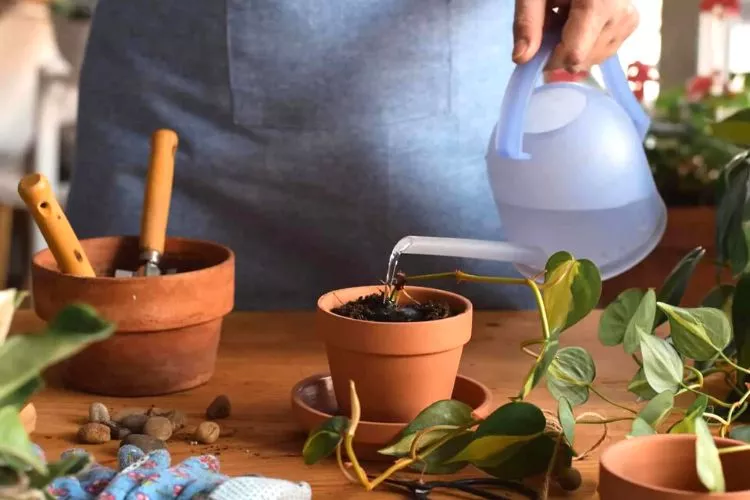
Table of Contents
Understanding Pothos Plants
Pothos plants are evergreen climbing vines that are native to the tropical conditions of the Solomon Islands. They are extremely popular houseplants because of their no fuss maintenance, attractive foliage, and air-purifying qualities, among other attributes.
Pothos plants feature lush, glossy, heart-shaped leaves that can grow anywhere up to 4-6 inches long. The leaves can be either green, yellow, or white, and some varieties can even have multi colored or marbled patterns. They really are a joy to nurture and watch grow.
Types of Pothos Plants
There are around 15 different species of Pothos plants worldwide. The most common types include:
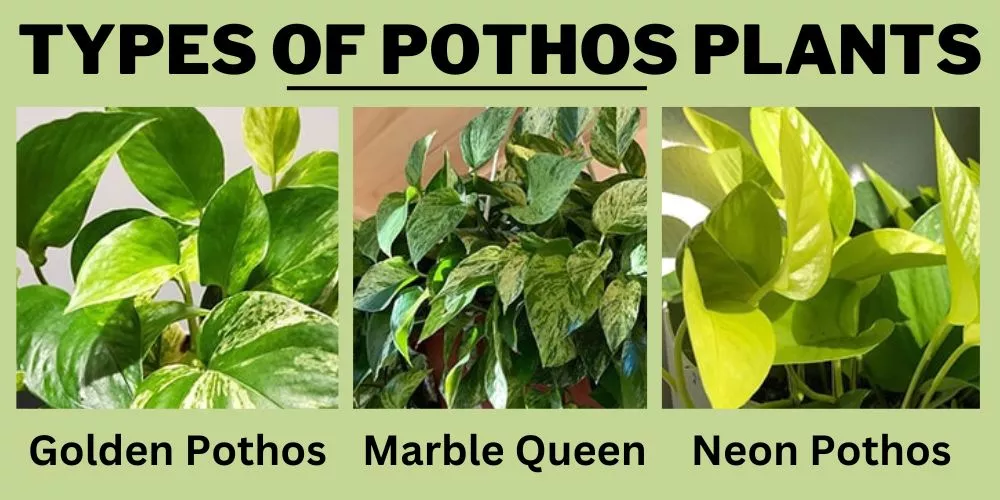
- Golden Pothos: The most common type of Pothos, featuring green leaves with yellow or white variegation.
- Marble Queen: This species has green leaves with white or cream-colored variegation that creates a mesmerizing marbled effect.
- Neon Pothos: Another favorite that presets bright, chartreuse-green leaves that have an uncanny tendency to add color to any room.
Ideal Growing Conditions for Pothos Plants
Pothos plants are quite easy to care for and can thrive in a variety of growing conditions. However, they do have some simple growing requirements, including:

- Bright, indirect light: These types of plants can tolerate low light, but they grow best in bright, indirect light.
- Well-draining soil: Pothos plants require soil that allows excess water to drain, preventing waterlogged soil and root rot. This is one of, if not the most important, need that should be met.
- Temperatures between 60-85°F: Pothos plants can tolerate a range of temperatures but prefer temperatures between 60-85°F.
- Humidity levels between 50-70%: The humble Pothos prefer humid conditions, but they can also tolerate drier air for short periods of time.
The Role of Drainage in Pothos Health
Now that we have covered the Pothos in short let’s look at the strong role that drainage plays in the life of a plant of this nature. Drainage is crucial to maintaining healthy and thriving Pothos plants.
In this section, we will explore the importance of drainage for these types of plants, how poor drainage affects them, and how to identify the symptoms of poor drainage.
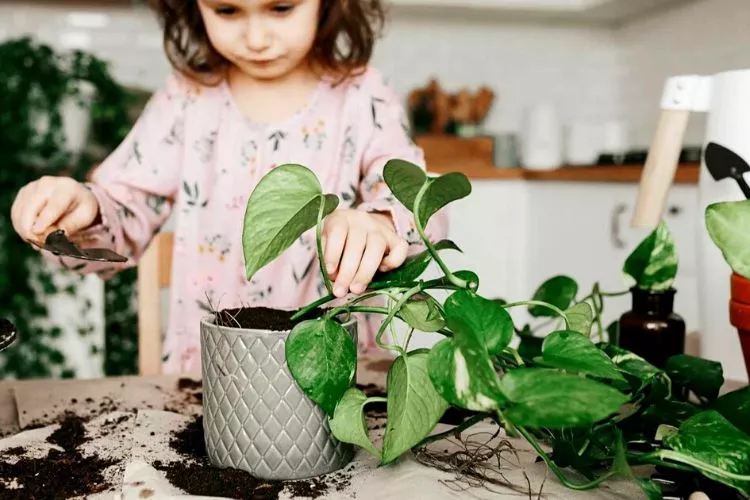
Definition of drainage
Drainage of a Pothos plant, or any plant for that matter, usually refers to the ability of the soil to allow excess water to escape, preventing waterlogged soil and root rot.
How poor drainage affects Pothos plants?
Adequate drainage is essential for the health and survival of Pothos plants, as overwatering or poor drainage can lead to a variety of much larger problems. These issues include yellowing or browning leaves, root rot, wilting leaves, stunted growth, and dripping leaves.
Proper drainage can be achieved by making use of pots with drainage holes, using a well-draining potting mix, and avoiding overwatering at the bottom of the pot.
Providing good drainage ensures that the Pothos plant has the proper balance of water and air in the soil, allowing the roots to grow and absorb both oxygen and nutrients, leading to healthy growth and overall plant health.
Symptoms of poor drainage of a Pothos plant
Symptoms of poor drainage of a Pothos plant can be quite noticeable and present visible changes in the leaves and stems of the plant. These symptoms generally occur due to a lack of oxygen in the roots caused by waterlogged soil, leading to nutrient deficiencies and root rot.
These symptoms can almost single-handedly be attributed to inadequate drainage. Common symptoms of poor drainage in Pothos plants include yellowing or browning leaves, drooping or wilting leaves, stunted growth, and dripping leaves. Let’s have a look at these symptoms in detail.
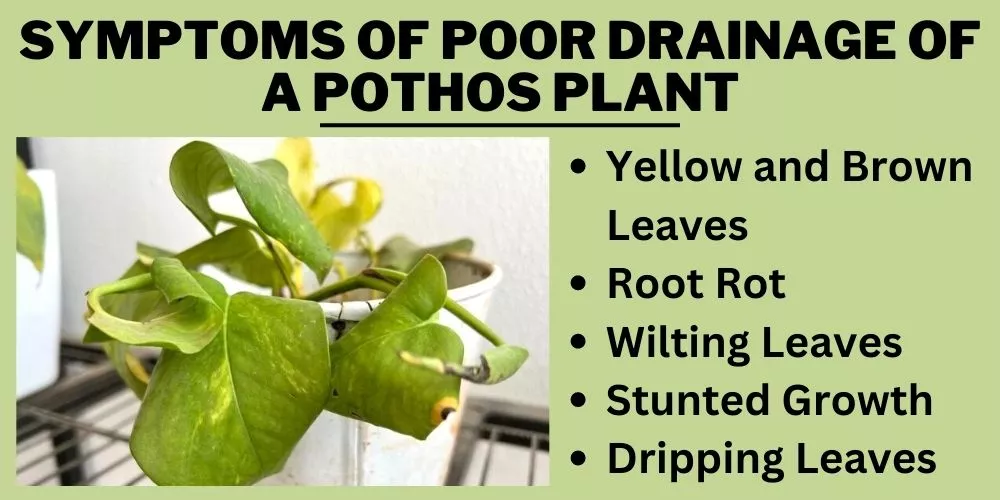
Yellow and Brown Leaves
One of the most common signs of poor drainage is yellowing or browning leaves. This occurs because the roots are unable to absorb the necessary nutrients from the soil due to being suffocated by excess water. This leads to nutrient deficiencies and leaf discoloration.
Root Rot
Another issue caused by poor drainage is root rot. Root rot occurs when the roots are continuously exposed to excess moisture, leading to fungal growth and decay. The pooling or stagnant water basically bathes the roots and denies them any oxygen.
As a result, the roots rot away in the water. Root rot can cause the roots to become mushy and dark-colored, making it difficult for them to actually absorb the water as well as nutrients, leading to poor plant health.
Wilting Leaves
When a Pothos plant is overwatered or has poor drainage, the leaves can wilt or droop due to a lack of oxygen. This is because excess water causes the soil to become compacted and reduces the amount of available air around the roots. When the plant doesn’t have all that it needs to grow, it will wilt before slowly dying.
Stunted Growth
Poor drainage can also cause stunted growth in Pothos plants. When the roots are exposed to excess water, they can become damaged and denied the necessary oxygen and nutrients for healthy growth. This can result in stunted growth, weak stems, and a lack of new leaves.
Dripping Leaves
Lastly, poor drainage can cause dripping leaves in Pothos plants. When the roots are overwatered, the excess water slowly moves up the stem and out of the leaves, causing water droplets to form at the leaf tips. While this may seem harmless, it can be a sign of overwatering and poor drainage.
If left untreated, the excess moisture will rot the whole plant out from root to tip before killing it.
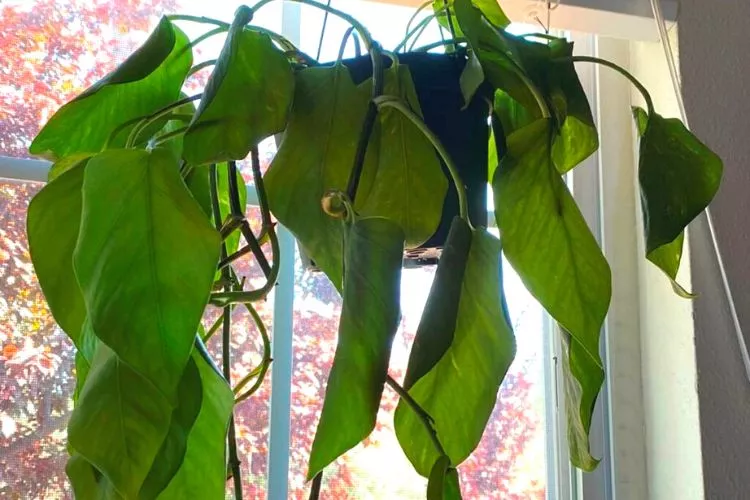
In summary, drainage is crucial for the general well being of a Pothos plant. Leaving them in this condition can lead to a variety of problems that can cause some real harm to your plant.
To avoid these issues, it’s essential to ensure that your Pothos plant has proper drainage and is not overwatered. In the next section, we will explore whether Pothos plants need drainage and how to ensure good drainage.
Do Pothos Need Drainage?
When it comes to Pothos plants, drainage is an essential factor to consider for optimal plant health. So, it does need drainage, but there are a few things to consider first before making that decision.
Let’s take a closer look at this issue.
Factors to Consider When Deciding if Pothos Plants Need Drainage
Several factors should be considered when understanding whether Pothos plants need drainage or not, including:
- The type of pot used and whether or not they have drainage holes
- The soil mixture used and whether or not it is amended for drainage or contains materials that restrict the flow of water.
- The watering habits of the plant owner.
- The plant’s location and growing conditions.
Advantages and Disadvantages of Using Drainage for Pothos Plants
While proper drainage is crucial for Pothos plant health, there are both advantages and disadvantages to using drainage. The key is to know your plant and understand its needs and then find a balance that suits them. Let’s have a look at the benefits and drawbacks of drainage below:
Advantages
✅ Prevents waterlogging and root rot in plants that cannot tolerate excess water.
✅ Helps to maintain proper soil moisture levels
✅ Promotes healthy root growth by allowing the water to pass by and drain away
✅ It provides better nutrient absorption for the plant by breaking them down and making them more soluble.
✅ Reduces the risk of pest infestations by minimizing stagnant water or pooling.
Disadvantages
❌ This leads to faster soil drying, requiring more frequent watering
❌ Causes soil erosion and nutrient depletion as it dries out
❌ Creates drainage problems if the pot is not placed on a level surface
❌ Causes water to seep onto surfaces and creates an often unnecessary mess
Expert Recommendations on Whether to Use Drainage for Pothos Plants
Most experts agree that proper drainage is crucial for Pothos plant health. However, the type and amount of drainage needed may vary depending on the individual plant’s needs and growing conditions. For example, larger plants can do with the extra moisture that may drain away faster than it utilizes it. There are many cases that pose questions. Here are some expert recommendations:
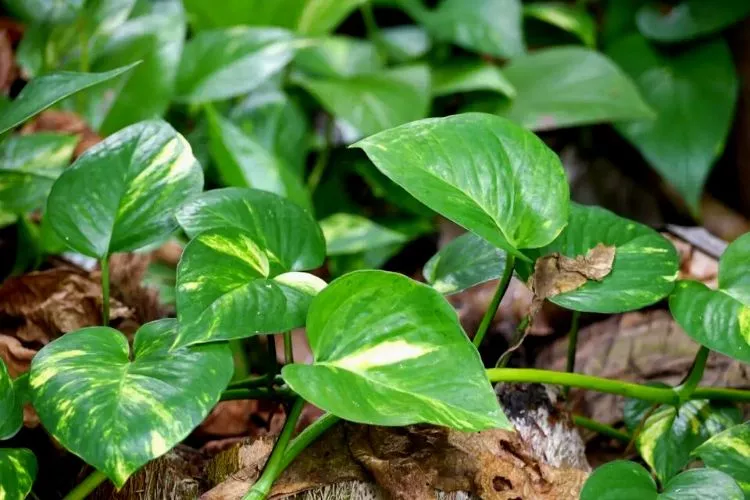
- Always use pots with drainage holes to prevent waterlogging and root rot. You can always add more water if it drains away too quickly.
- Use a well-draining potting mix that allows excess water to escape. Optimal materials are generally coarse and include sand, gravel, perlite, etc.
- Water Pothos plants thoroughly, allowing excess water to escape the drainage holes. Repeat if necessary.
- Avoid overwatering and allowing water to sit in the saucer for extended periods. Remove any excess pools of water where possible.
- Monitor your plant’s growth and adjust your watering habits accordingly. Some larger species can soak up the water quite fast and may need more moisture during warmer months.
In summary, while the specific amount and type of drainage needed for Pothos plants may vary, proper drainage is crucial for their health and survival. Using pots with drainage holes, a well-draining potting mix, and proper watering habits can help prevent common issues like root rot, yellowing leaves, and stunted growth. In the next section, we will explore how to ensure good drainage for Pothos plants.
How to Ensure Good Drainage for Pothos Plants?
Ensuring good drainage is a key factor in the health and overall survival of Pothos plants. Here are some tips to help you provide your Pothos plant with the proper drainage it needs:
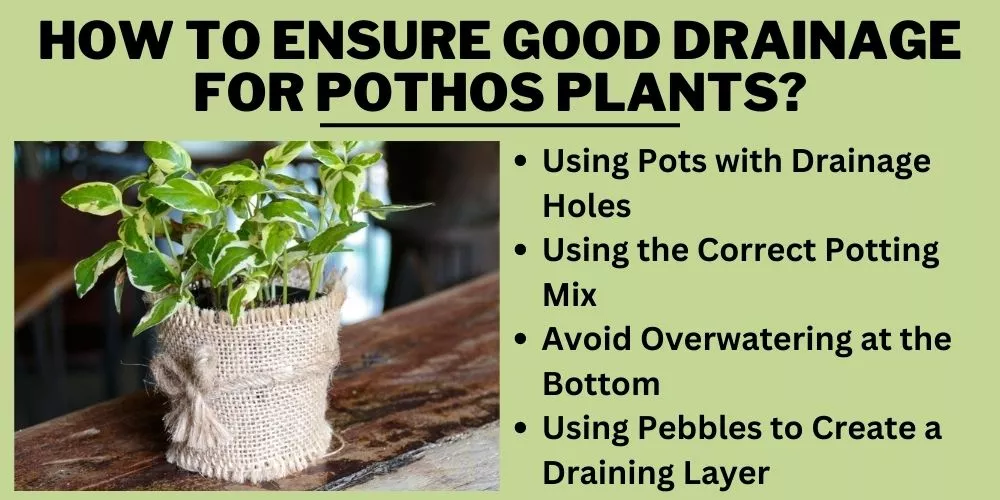
Using Pots with Drainage Holes
Using pots or containers with drainage holes is one of the most critical factors for ensuring good drainage. The drainage holes allow excess water to escape, which ultimately prevents waterlogging and root rot. When it comes to selecting a pot for your Pothos plant, look for one with at least 3-4 decent sized holes at the base.
You can even drill some out if you know your way around some basic hand or electric tools. Also, ensure that the drainage holes are not getting clogged up by clumping growing materials.
If you’re worried about the mess that the runoff makes, simply place a saucer under the pot to collect excess water and prevent damage to surfaces. Change the saucer over once a week to keep it from overflowing.
Using the Correct Potting Mix
Use a well-draining potting mix to ensure that your Pothos plant has the air and space underground to sprawl and grow. A well-draining potting mix allows excess water to escape, preventing waterlogging and root rot. To create a well-draining potting mix, you can add coarse materials like perlite or vermiculite to your regular potting mix.
Avoid using heavy soils such as clay or peat that retain too much moisture. Make sure that the potting mix you use is suitable for indoor plants, as some outdoor potting mixes can cause clumping issues when used indoors.
Avoid Overwatering at the Bottom
Overwatering is a recipe for disaster. The excess water will run straight to the bottom of the pot and accumulate. This stagnant pool of water leads to poor drainage and root rot. To avoid overwatering at the bottom of the pot, water your Pothos plant until the water runs out of the drainage holes.
Once you have finished watering, empty the saucer under the pot to prevent water from sitting in the bottom. Adjust your watering habits based on the specific plant’s needs and growing conditions. Remember that different plants require different amounts of water and at differing rates.
Using Pebbles to Create a Draining Layer
Using a layer of pebbles at the bottom of the pot can also help promote good drainage. Simply add a layer of pebbles at the bottom of the pot before adding the potting mix. Ensure that the pebble layer is thick enough to promote drainage but not too thick to prevent the pot from being filled with an adequate volume of soil.
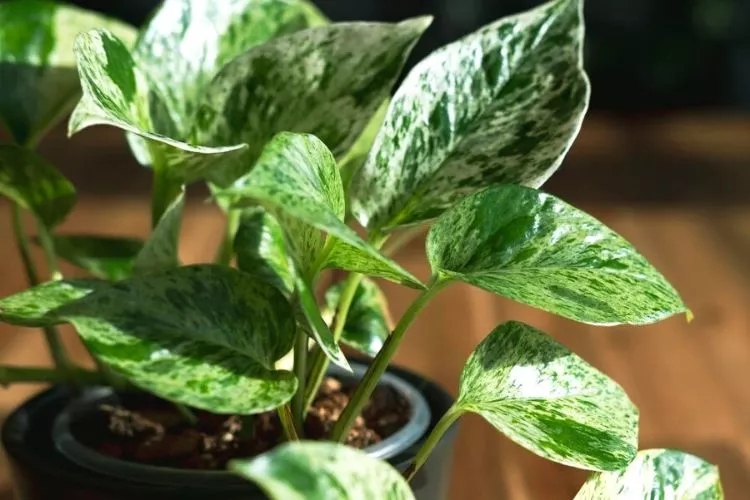
Be careful not to compact the pebbles too much, as this can affect drainage. A draining layer with pebbles allows water to pass through freely, especially when using a pot without any drainage holes or minimal drainage holes.
Common Mistakes to Avoid When Using Drainage
As simple as it sounds, achieving optimal drainage can be a bit of a balancing act. Here are some common mistakes to avoid when applying principles to achieve the right amount of drainage:
- Using pots without drainage holes
- Using heavy soils that do not drain well
- Overwatering or watering too frequently
- Allowing water to sit in the saucer under the pot for extended periods
- Not adjusting watering habits based on the specific plant’s needs
There isn’t really much else to it. Try to keep these basic principles in mind when setting up a home for your Pothos plant. Always remember that some plants have different requirements from others, and a lot of varying factors can alter these needs.
All in all, avoiding these common mistakes can help to prevent any debilitating issues like root rot and yellowing leaves.
Frequently Asked Questions (FAQs)
Can pothos survive in pots without drainage?
It is possible for Pothos to survive in pots without drainage, but it does increase the risk of waterlogged soil and root rot. It’s best to use pots with drainage holes to allow excess water to escape and prevent these problems altogether.
Is it better to bottom water pothos?
Bottom watering can be a suitable method for watering Pothos plants, as it prevents water from actually sitting stagnant in the bottom of the pot, which can lead to poor drainage and root rot. Instead, the soil is sucked up via a saucer placed underneath and changed once empty.
Can you fully submerge pothos in water?
Pothos can be grown in water, but fully submerging the plant can lead to rot and disease. It’s best to grow Pothos in a well-draining potting mix and water the plant until the excess water drains out of the pot’s drainage holes.
Conclusion:
In conclusion, adequate drainage is crucial for the health and well-being of your Pothos plant. Without proper drainage, your plant can show signs of yellowing leaves and stunted growth as its roots begin to rot.
Using pots with drainage holes, the correct potting mix, avoiding overwatering at the bottom, and using pebbles to create a draining layer are all effective methods for ensuring good drainage.
By following these tips, you can help your Pothos plant thrive and enjoy a long and healthy life. We hope that this guide has been helpful, and be sure to check out our website for similar topics and more helpful tips.


